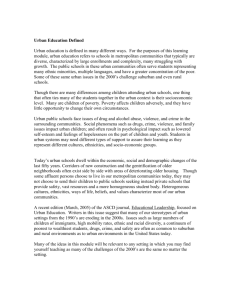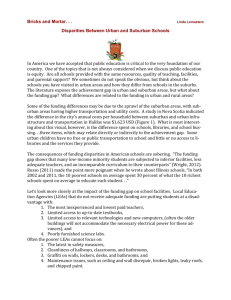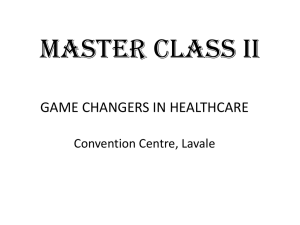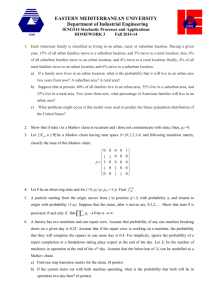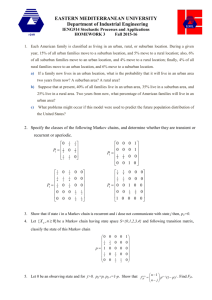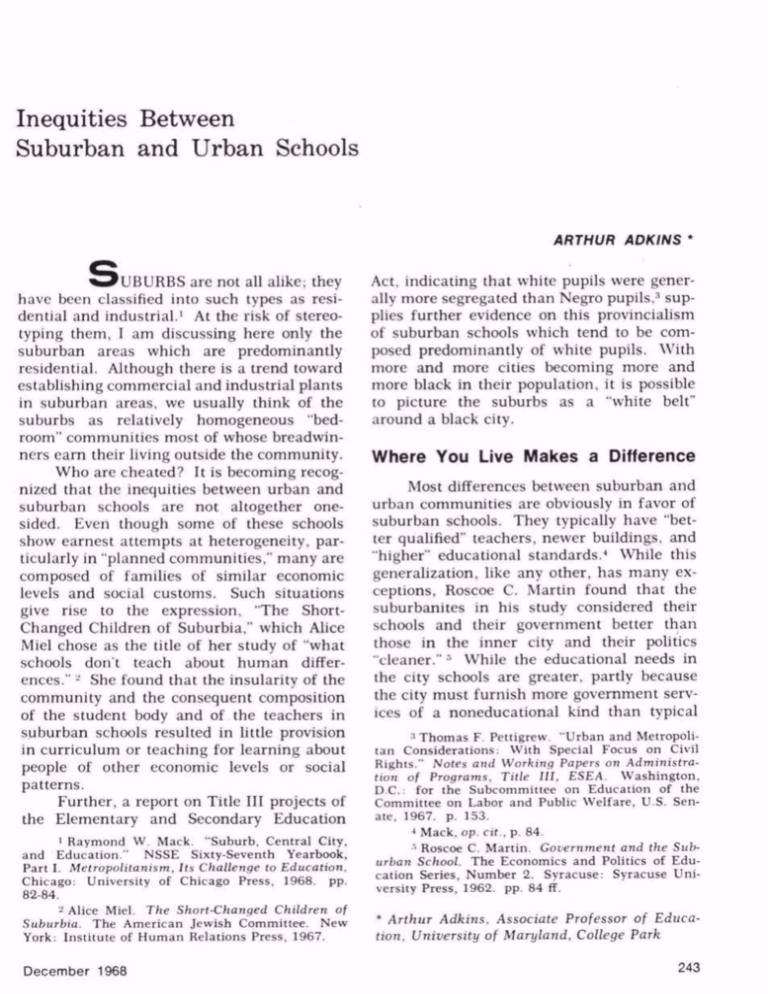
Inequities Between
Suburban and Urban Schools
ARTHUR ADKINS *
are not all alike; they
have been classified into such types as resi
dential and industrial. 1 At the risk of stereo
typing them, I am discussing here only the
suburban areas which are predominantly
residential. Although there is a trend toward
establishing commercial and industrial plants
in suburban areas, we usually think of the
suburbs as relatively homogeneous "bed
room" communities most of whose breadwin
ners earn their living outside the community.
Who are cheated? It is becoming recog
nized that the inequities between urban and
suburban schools are not altogether one
sided. Even though some of these schools
show earnest attempts at heterogeneity, par
ticularly in "planned communities," many are
composed of families of similar economic
levels and social customs. Such situations
give rise to the expression, "The Short
changed Children of Suburbia," which Alice
Miel chose as the title of her study of "what
schools don't teach about human differ
ences." - She found that the insularity of the
community and the consequent composition
of the student body and of the teachers in
suburban schools resulted in little provision
in curriculum or teaching for learning about
people of other economic levels or social
patterns.
Further, a report on Title III projects of
the Elementary and Secondary Education
i Raymond W. Mack. "Suburb, Central City,
and Education." NSSE Sixty-Seventh Yearbook,
Part I. Metropolitanism, Its Challenge to Education,
Chicago: University of Chicago Press, 1968. pp.
82-84.
- Alice Miel. The Short-Changed Children of
Suburbia. The American Jewish Committee. New
York: Institute of Human Relations Press, 1967.
December 1968
Act, indicating that white pupils were gener
ally more segregated than Negro pupils, 3 sup
plies further evidence on this provincialism
of suburban schools which tend to be com
posed predominantly of white pupils. With
more and more cities becoming more and
more black in their population, it is possible
to picture the suburbs as a "white belt"
around a black city.
Where You Live Makes a Difference
Most differences between suburban and
urban communities are obviously in favor of
suburban schools. They typically have "bet
ter qualified" teachers, newer buildings, and
"higher" educational standards. 4 While this
generalization, like any other, has many ex
ceptions, Roscoe C. Martin found that the
suburbanites in his study considered their
schools and their government better than
those in the inner city and their politics
"cleaner." •"' While the educational needs in
the city schools are greater, partly because
the city must furnish more government serv
ices of a noneducational kind than typical
:i Thomas F. Pettigrew. "Urban and Metropoli
tan Considerations: With Special Focus on Civil
Rights." N otes and Working Papers on Administra
tion of Programs, Title HI, ESEA. W ashington,
D.C.: for the Subcommittee on Education of the
Committee on Labor and Public Welfare, U.S. Sen
ate, 1967. p. 153.
J Mack, op. c it., p . 84.
•"• Roscoe C. Martin. Government and the Sub
urban School. The Economics and Politics of Edu
cation Series, Number 2. Syracuse: Syracuse Uni
versity Press, 1962. pp. 84 ff.
* A rthur Adkins. Associate Professor of Educa
tion, University of Maryland, College Park
243
suburban communities do,n suburban schools
ordinarily benefit more from state aid than
do urban schools. They typically have both
a higher enrollment ratio and a greater aver
age grant per pupil. 7 Suburban communities,
with greater per capita financial resources at
their disposal, devote considerably more of
their financial resources to education than do
urban communities."•"
The comparative recency of these phe
nomena and the growing urgency of the prob
lems they raise are attested to by the differing
rates of population increase in suburban and
urban areas. In the period from 1950 to
1960, when the urban population increased
by 10.7 percent, the metropolitan population
outside the central city increased by 48.6 per
cent." It may be trae, as Havighurst has pre
dicted, that the economic and racial polariza
tion between the suburb and central city may
have reached its maximum and that from now
on they may become more like one another.
As he mentions, they are already one com
munity to newspapers and television stations,
but "cooperation between suburbs and the
central city will come slowly and with more
difficulty in the areas of government and edu
cation." '" In any event the inequities cited
here do exist and are likely to be with us for
some time to come.
Some of the current measures which are
ostensibly intended to bring about greater
equality of educational opportunities may in
fact perpetuate some of these inequalities.
As a Senate Committee report says:
|; Seymour Sacks. "Central City and Suburban
Education: Fiscal Resources and Fiscal Realities."
NSSE Sixty-Seventh Yearbook, Part I. Metropolitanism. Its Challenge to Education. C hicago: Uni
versity of Chicago Press, 1968. p. 163.
' I bid , p . 162.
" Committee on Educational Finance. "Finan
cial Status of the Public Schools." Washington,
D.C.: National Education Association, 1968. Table
29, p. 59.
;i Alan K. Campbell and Phillip Meranto. "The
Metropolitan Education Dilemma: Matching Re
sources to Needs." (From: U.S. Census, 1960.) Edu
cating a n Urban Population. Beverley Hills, Califor
nia: Sage Publications, 1967. p. 18.
111 Robert J. Havighurst. "Introduction." NSSE
Sixty-Seventh Yearbook, Part I. Metropolitanism,
Its Challenge to Education. Chicago: University of
Chicago Press, 1968. pp. 8-9.
244
. . . racial discrimination would be easily
possible. . . . This feature operates in two ways.
First, the 1965 ESEA is designed like the annual
rivers and harbors bill; that is, its funding is
distributed throughout the nation's 27,000 school
districts in virtually an everyone-gets-his-cut,
pork-barrel manner. 11
The report asserts that the established
pattern of funding individual school districts
is anti-metropolitan in its consequences since
cooperation over a larger metropolitan area
is not required to receive this federal support.
The report also points out that over half of
metropolitan whites live in suburbs, while
over 80 percent of metropolitan Negroes live
of necessity in central cities. The committee's
report recommends that federal funds be al
located in such a way as to encourage racial
integration, bringing together the advantaged
and disadvantaged in large area metropolitan
cooperation. 12
For Equality
Two primary arguments are usually ad
vanced for promoting equality of educational
opportunity through school taxation. First, a
pupil's geographical location should not deter
mine or limit the quality of his education.
Second, it is argued that while "beneficial"
local taxation for purely local benefits (such
as garbage collection) may be appropriate for
purely local support, "onerous" taxation for
purposes (like education) which are of con
cern to the entire nation should be supported
nationally. 13 We might add to the first prin
ciple that neither a person's "race" nor the
economic position of his parents should de
termine the quality of his education, and to
the second that the world-wide awareness of
our treatment of minorities and of widespread
urban unrest has serious effects on our coun
try's international posture.
In a historical analysis of local and
school politics in a suburban community, it
was concluded that education issues are usu
ally not of concern to most laymen unless
11 Pettigrew, op. cit., p . 155.
11 Ibid., p . 162.
13 Charles S. Benson. The Economics of Pub
lic Education. B oston: Houghton Mifflin Company,
1961. pp. 218-19.
Educational Leadership
somehow related to other issues such as zon
ing, taxation, and industrialization." This
may be true particularly when it comes to
enforcing laws, rather than making them. It
is possible that laws on school attendance
could be passed through the lobbying efforts
of interested groups (such as those desirous
of ending child labor) but could not be effec
tively enforced until the labor market no
longer needed children. If politics is the "art
of the possible," legislation designed to allevi
ate the inequities cited above may be long in
coming. A flood of national legislation, and
some state and local, has followed the U.S.
Supreme Court decisions on school desegre
gation, but effective enforcement of such
laws is slow indeed.
New legislation designed to equalize ed
ucational opportunity is possible. The Ad
visory Commission on Intergovernmental
Relations has prepared a model for such
legislation on the state level. 1 "' Since this,
however, would not resolve the national prob
lem, federal legislation and federal funds will
undoubtedly be necessary. A current court
case in Detroit may well result in a landmark
decision rivaling K alamazoo " ' and B rown 1 T
in its effects.
Equal Protection of the Laws
A complaint has been filed as a civil
action by the Detroit Board of Education and
a group of Detroit pupils and their parents,
against the State of Michigan and the State
14 Keith Goldhammer and Roland J. Pellegrin.
"Jackson County Revisited." A Case S tudy in Poli
tics of Public Education. U niversity of Oregon
Press: Center for the Advanced Study of Educa
tional Administration, 1968. p. 87.
lr'John Shannon. "The Role of the State in
Equalizing Educational Opportunity — An ACIR Leg
islative Proposal." The Challenge of Change in
School Finance. Proceedings of the 10th National
Conference on School Finance Washington, D.C.:
NEA Committee on Educational Finance, 1967. pp.
31-47.
111 Charles E. Stuart <?( a l. v. S chool District
No. 1 of the Village of Kalamazoo, 30 M ichigan,
1874. This decision by the Michigan State Supreme
Court upheld the right of communities to levy and
collect taxes for support of public high schools.
17 Brown v . B oard of Education, I, 1954. The
U.S. Supreme Court outlawed desegregation in
schools.
December 1968
Treasurer, in Wayne County Circuit Court. 1 *
The complaint alleges that the State has
failed to discharge its obligation to provide
for free public education on an equal basis
for all, in violation of the Fourteenth Amend
ment to the Constitution of the United States:
". . . nor shall any State . . . deny to any per
son within its jurisdiction the equal protec
tion of its laws."
The complaint charges that by its appli
cation of the School Aid Act of 1957, and
especially its formula for apportionment of
state aids, substantial disparities exist in
financing public education in the several dis
tricts, and that the State denies equal educa
tional opportunity by failing to relate aid to
the varying needs and resources of the dis
tricts, failing to take into account substantial
differences in costs of buildings and person
nel, and failing to provide for the added
costs of educating disadvantaged pupils in
urban areas.
The Court is requested to declare the
School Aid Act void as "repugnant to the
equal protection clause of the Fourteenth
Amendment," and, after giving the Legisla
ture a reasonable time to reapportion State
funds to provide equal opportunity, per
manently enjoin the Treasurer from further
execution of the Act if it fails to do so. The
Court is requested then to order an equitable
distribution.
While this will probably take years, and
may well come at length to the U.S. Supreme
Court, the case is an epochal one, with pos
sible consequences more far-reaching than
almost any other.
It seems worthy of note that The ShortChanged Children of Suburbia, even in its
"action program." suggests no changes in
those political-economic-demographic-legal
conditions which brought about the pro
vincialism described there. 11* Perhaps this
Q
case will make such changes.
i s Board of Education of the School District
of the City of Detroit. "Complaint." A General Civil
Action 11. The State of Michigan and Allison Green,
Its Treasurer, in the Circuit Court for the County
of Wayne (Miller, Canfield, Paddock, and Stone,
Attorneys for Plaintiffs; undated typescript); case
pending.
i" Miel, o p. cit., p . 67-68.
245
Copyright © 1968 by the Association for Supervision and Curriculum
Development. All rights reserved.

